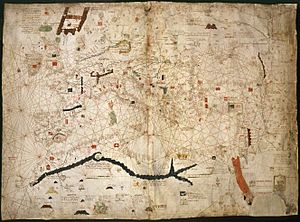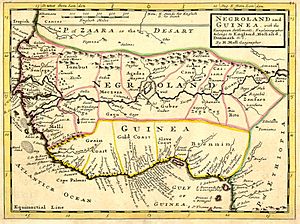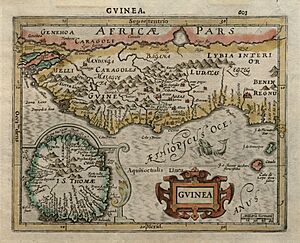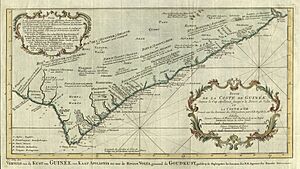Guinea (region) facts for kids
Guinea is an old name for a large coastal area in West Africa. This region stretches along the Gulf of Guinea. It's a naturally wet area with tropical forests or savannas. It borders the drier Sahel region to the north.
Contents
Where the Name "Guinea" Comes From

The exact origin of the name "Guinea" is not fully known. However, there are a few main ideas about where it came from.
Early European Use
The English word Guinea comes from the Spanish word Guinea. This word, in turn, came from the Portuguese word Guiné. Portuguese explorers started using this term in the mid-1400s. They used it to describe the lands where the Guineus lived. This was a general term the Portuguese used for the Black African people living south of the Senegal River. It helped them tell these groups apart from the lighter-skinned Berber people to the north.
Berber Language Connection
Many believe the Portuguese word Guineus came from the Berber term Ghinawen. This word meant "the burnt people." It's similar to the ancient Greek word Aithiops, which also meant "of the burned face." In Berber, "aginaw" means "black," and "Akal n-Iguinawen" means "land of the blacks."
Link to the City of Djenné

Another idea, first suggested by Leo Africanus in 1526, is that "Guinea" came from the name Djenné. Djenné was a very important trading city on the Upper Niger River. It was a major center for the gold and salt trade across West Africa for many years. During the time Djenné was most powerful, the term Genewah became common in Arab writings. This term referred to the land controlled by that city.
Some theories also try to connect "Guinea" to the Ghana Empire. However, this link is less certain. It's possible that both Ghana and Djenné got their names from the Berber word for the Black people who lived there. So, the Berber word for "blacks" might have led to the city name Djenné, which then led to the Arabic Genewah, and finally to the Portuguese Guiné.
A Look at Guinea's History
In 1478, during a war between Spain and Portugal, a big naval battle took place off the coast of Elmina. Thirty-five Spanish ships fought a Portuguese fleet. They were fighting for control over the valuable trade in Guinea, which included gold, ivory, and enslaved people. Portugal won this battle. Later, in 1479, a treaty officially recognized Portugal's control over most of these African territories. This was one of the first of many wars between European powers over colonies. After Portugal and Spain, other countries like the Dutch, Danes, French, and British also came to the region.
Wealth and Resistance
The rich trade in ivory, gold, and people forced into labor made the Guinea region very wealthy. Because of this wealth, several strong kingdoms grew in the 1700s and 1800s. These kingdoms were smaller than the large states in the open Sahel region. However, they had more people living closer together and were more organized politically.
The strength of these kingdoms meant that the Guinea region resisted European attempts to take over more than other parts of Africa. Also, many diseases in the area were dangerous for Europeans. Because of these reasons, much of Guinea was not fully colonized by Europeans until the very end of the 1800s.
How Guinea is Divided
The Guinea region is often split into "Lower Guinea" and "Upper Guinea".
- Lower Guinea is one of the most crowded parts of Africa. It includes southern Nigeria, Benin, Togo, and parts of Ghana. This area covers both the coastal regions and the land further inland.
- Upper Guinea has far fewer people. It stretches from Côte d'Ivoire to Senegal.
Within the modern country called the Republic of Guinea, "Lower Guinea" refers to its coastal plain. "Upper Guinea" refers to the country's inland areas.
Trade-Based Divisions
European traders also divided the region based on its main exports.
- The eastern part, around Benin and Nigeria, was called the Slave Coast. This name came from the large number of people who were captured and forced into labor there.
- What is now Ghana was known as the Gold Coast. This name was later given to a British colony in the area.
- West of the Gold Coast was the Ivory Coast. This is still the name of the country in that region today.
- The farthest west area, around modern Liberia and Sierra Leone, was called either the Pepper Coast or the Grain Coast.
Countries in the Guinea Region
Many countries today are part of the historical Guinea region. From north to south, they include:
- Senegal (once controlled by France)
- The Gambia (once controlled by Britain)
- Guinea-Bissau (once called Portuguese Guinea)
- Guinea (once called French Guinea)
- Sierra Leone (a British area, part of the Pepper Coast)
- Liberia (founded by former enslaved people from the U.S. on the Pepper Coast)
- Ivory Coast or Côte d'Ivoire
- Ghana (once the Gold Coast; other European colonies like Danish, Dutch, Portuguese, Prussian, and Swedish Guinea were absorbed by the British Gold Coast)
- Togo (once called Togoland)
- Benin (once called Dahomey)
- Southern Nigeria
See also
 In Spanish: Guinea (región) para niños
In Spanish: Guinea (región) para niños
- Lower Guinean forests
- Upper Guinean forests
- West Africa
- New Guinea
- Guineaman, a type of ship used to transport enslaved people from the Guinea region




